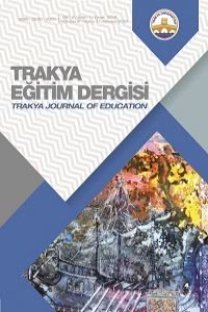ÖĞRENME ORTAMLARINDAKİ (OKUL, EV, MÜZE VE TOPLUM) BİLİMSEL MERAK ÖLÇEĞİNİN TÜRKÇEYE UYARLANMASI: GEÇERLİLİK VE GÜVENİRLİLİK ÇALIŞMASI
In this study, The Scientific Curiosity (SCILE) scale in learning environments such as school, home, museum, and society developed by Weible and Zimmerman (2016) to translate Turkish language and a validity and reliability study was conducted. For language validity study, the scale was translated into Turkish by the language and field experts. The Turkish form was translated into English by a language specialist and compared to the original structure, and the scale was finalized. The data were collected from 284 students in two different high schools in a province in the Eastern Anatolia region. The data were analyzed by Exploratory Factor Analysis. The exploratory factor analysis results demonstrated that the questionnaire has two-dimensional structure and ten items. Cronbach Alpha internal consistency coefficient of the scale was found in ,799. The findings indicate that the ÖOBM scale is a valid measurement to measure high school student’s scientific curiosity in a learning environment such as schools, homes, museums, and society.
Anahtar Kelimeler:
Learning Environments, Scientific Curiosity, High School Students
___
- Acun, N., Kapıkıran, Ş., & Kabasakal, Z. (2013). Merak ve keşfetme ölçeği II: Açımlayıcı ve doğrulayıcı faktör analizleri ve güvenirlik çalışması. Türk Psikoloji Yazıları, 16(31), 74-85.
- Ainley, M. (2019). Curiosity and interest: Emergence and divergence. Educational Psychology Review, 1-18.
- Berlyne, D. E. (1954). A theory of human curiosity. British Journal of Psychology. General Section, 45(3), 180–191.
- Büyüköztürk, Ş. (2011). Sosyal Bilimler İçin Veri Analizi El Kitabı. Ankara: Pegem Akademi.
- Clark, S., & Seider, S. (2017). Developing critical curiosity in adolescents. Equity & Excellence in Education, 50(2), 125-141.
- Collins, R. P., Litman, J. A., & Spielberger, C. D. (2004). The measurement of perceptual curiosity. Personality and individual differences, 36(5), 1127-1141.
- Cook, R. A. (2012). Curiosity: The mars science laboratory project.
- Egan, K., Cant, A. I., & Judson, G. (Eds.). (2013). Wonder-full education: The centrality of wonder in teaching and learning across the curriculum. Routledge.
- Engel, S. (2011). Children's need to know: Curiosity in schools. Harvard educational review, 81(4), 625-645
- Engel, S., & Randall, K. (2009). How teachers respond to children’s inquiry. American Educational Research Journal, 46(1), 183-202.
- Engelhard Jr, G., & Monsaas, J. A. (1988). Grade level, gender, and school-related curiosity in urban elementary schools. The Journal of Educational Research, 82(1), 22-26. M. (2018).
- Jirout, J. J., Vitiello, V. E., & Zumbrunn, S. K. (2018). Curiosity in schools. In G. Gordon (Ed.), Psychology of emotions, motivations and actions. The new science of curiosity (p. 243–265). Nova Science Publishers.
- Kashdan, T. B., & Steger, M. F. (2007). Curiosity and pathways to well‐being and meaning in life: Traits, states, and everyday behaviors. Motivation and Emotion, 31, 159–173.
- Kashdan, T. B., Gallagher, M. W., Silvia, P. J., Winterstein, B. P., Breen, W. E., Terhar, D., & Steger, M. F. (2009). The curiosity and exploration inventory-II: Development, factor structure, and psychometrics. Journal of Research in Personality, 43(6), 987–998.
- Lindholm, M. (2018). Promoting Curiosity?. Science & Education, 27(9-10), 987-1002.
- Post, T., & van der Molen, J. H. W. (2019). Development and validation of a questionnaire to measure primary school children’s images of and attitudes towards curiosity (the CIAC questionnaire). Motivation and emotion, 43(1), 159-178.
- Post, T., & Walma van der Molen, J. H. (2018). Do children express curiosity at school?: Exploring children's experiences of curiosity inside and outside the school context. Learning, Culture and Social Interaction, 18, 60-71.
- Risko, E. F., Anderson, N. C., Lanthier, S., & Kingstone, A. (2012). Curious eyes: Individual differences in personality predict eye movement behavior in scene-viewing. Cognition, 122(1), 86-90.
- Serin, G. (2010). İlköğretim 7. Sınıf öğrencilerin fene karşı meraklarının incelenmesi. Mustafa Kemal Üniversitesi Sosyal Bilimler Enstitüsü Dergisi, 13(7), 237–252.
- Shneidman, L., Gweon, H., Schulz, L. E., & Woodward, A. L. (2016). Learning from others and spontaneous exploration: A cross‐cultural investigation. Child Development, 87(3), 723-735.
- Silvia, P. J. ve Kashdan, T. B. (2009). Interesting things and curious people: Exploration and engagement as transient states and enduring strengths. Social and Personality Psychology Compass, 3(5),785-797
- Strandburg, K. (2005), "Curiosity-Driven Research and University Technology Transfer", Libecap, G. (Ed.) University Entrepreneurship and Technology Transfer (Advances in the Study of Entrepreneurship, Innovation and Economic Growth, Vol. 16), Emerald Group Publishing Limited, Bingley, pp. 93-122. https://doi.org/10.1016/S1048-4736(05)16004-4
- Weible, J. L., & Zimmerman, H. T. (2016). Science curiosity in learning environments: developing an attitudinal scale for research in schools, homes, museums, and the community. International Journal of Science Education, 38(8), 1235-1255.
- Whitesides, G. M. (2018). Curiosity and science. Angewandte Chemie International Edition, 57(16), 4126-4129.
- ISSN: 2630-6301
- Yayın Aralığı: Yılda 3 Sayı
- Başlangıç: 2011
- Yayıncı: Trakya Üniversitesi Eğitim Fakültesi
Sayıdaki Diğer Makaleler
Mahmut Serkan YAZICI, Damla CUMALI
ÖĞRETMENLERİN TEKNOSTRES DÜZEYLERİNİN ÇEŞİTLİ DEĞİŞKENLERE GÖRE DEĞERLENDİRİLMESİ: EDİRNE İLİ ÖRNEĞİ
ÖĞRETMEN SABIR ÖLÇEĞİ: GEÇERLİK VE GÜVENİRLİK ÇALIŞMASI
Serpil RECEPOĞLU, Mahmut Sami KILIÇ
Tuğba ECEVİT, Sena ALAGÖZ, Neslihan ÖZKURT, Ümmühan KARATAŞ KÖYLÜ
FEN EĞİTİMİNİN ORTAOKUL ÖĞRENCİLERİNDE ÜSTBİLİŞSEL FARKINDALIK ÜZERİNDEKİ ROLÜNÜN İNCELENMESİ
Ayşegül KINIK TOPALSAN, Dilek ÖZALP
YARATICI DÜŞÜNMEYİ KONU ALAN ULUSAL ÇALIŞMALARA YÖNELİK BETİMSEL İÇERİK ANALİZİ
